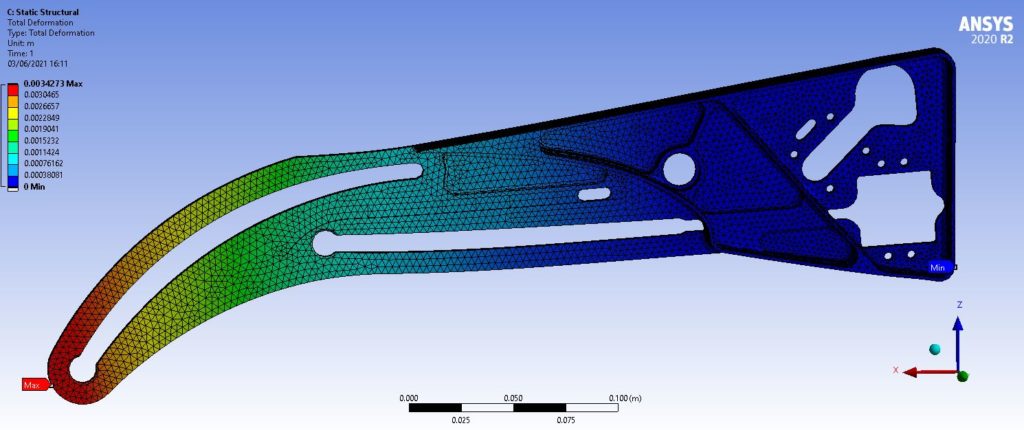This site uses cookies so that we can provide you with the best possible user experience. The information about cookies is stored in your browser and performs functions such as recognizing you when you return to our website and helping our team understand the sections of the site that you find most interesting and useful.
01.07.2021
Behind the scenes: Testing
Without testing what we design and what we carry out, we can’t know if all the technologies and the elements of our UR-1 Swiss all-electric race plane will work properly. This crucial phase allows us to be aware of all the modifications and the eventual corrections we have to do on our project.
Between the engineering and the manufacturing procedures, there are a lot of stress analyses and structural tests on materials loads to be done. These analyses will then allow us to define the materials weak points, for example.
The reason why we need these datas is related to the need for us to manage a complicated balance between variables and limitations on our electric aircraft. More in detail, we talk about loads, stiffness or stress of the materials we are using to build the UR-1.
These tests are not only done during the design phase but also after the manufacturing. It’s obvious that we need to check the functioning of every single part we are using.
Essentially, the purpose of all of those tests is to guarantee that the manufactured parts will work as expected, and also to deeply know the materials we are working with, when only a few datas do previously exist.
First steps

All the materials we are using to build the first Swiss electric race plane have to undergo a myriad of tests.
The overall stress analyses during the design process aim to size the parts, choose the most suitable material and the best method to assemble elements together. This analysis phase is made to validate the designed parts, before they go to manufacture. Taken into account are the materials properties, the shape and the size of the part, including a thorough check of its load path. Through this step, we are able to carry out the transition from a rough idea to a detailed one.
The survey made to collect those data follows well-known engineering formulas and FEA (Finite element analysis). The decision about what kind of mechanical tests we need to do, once the UR-1 part is manufactured, mainly relies on what information we need, e.g. part behaviour under load and stress. Also defining are the extra regulations required by aviation safety.
Structural tests

The amount of tests we do on a single part of the UR-1 electric aircraft depends on its own characteristics. Some parts don’t need to be tested because their resistance, with respect to the loads that go through, gives them a high FoS (Factor of Safety). This makes us sure that the part will work as expected without any doubts.
Other parts, with a lower FoS or made of new materials, are tested up to their limit load, where no plasticity shall occur, or up to their ultimate load, where a failure is expected to happen. A way to do these tests is to add loads gradually.
Sometimes, a single test of a component is not sufficient, so we replicate the test many times in order to get a representative set of values for the properties measured. We usually test 3 samples of each type of material, like our wing ribs made of wood.
Post-production inspection
After the manufacturing process, the stress analysis team is used to do many tests on the parts. The first step is to inspect them visually in order to see if the quality and the dimensions are as expected. If needed, we can require a closer visual inspection on critical parts areas where we have to make sure everything is alright. If we detect any irregularities, we will further investigate.
Then, concrete tests can be organized on some of the parts such as bringing them up to their limit loads in order to see if they withstand the requirements they have to deal with.
NCA - Non Conformity Report
If an irregularity is found on a part, visually or after testing, we always fill out a so-called NCA (Non Conformity Report). This report, that we will store in our archives, will contain what defects were found and what are the further steps with the parts :
- Acceptation: the defect is within tolerances
- Repair: the part can be used upon modifications or repairs
- Rejection: the part will be manufactured again.
In any case, if an irregularity is found after inspection, we analyze why it happened and we correct our processes in order to avoid the misissue in the future.
Tools
The stress analysis team does most of its tests on the computer. Literature results and studies represent a basis to start with. It gives it information on material properties and the expected behavior of standard parts.
When dealing with self-designed parts, or parts with a material which is not referenced in the literature, we need calculation tools to get a first rough sizing. Sometimes, we also need to create a script in order to treat a bigger batch of cases and parameters more easily and quickly.
We, at Pie Aeronefs SA, use a Finite element analysis software to optimize our results and to compare the theoretical behavior of the parts with the real one. At all time, our mission is to succeed in every test and to batten down the hatches when a problem does occur.
Safety is and will always be our main concern.
